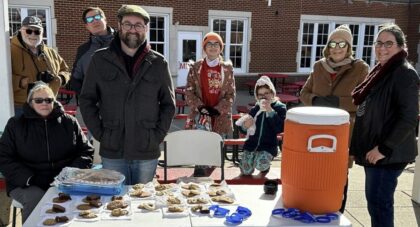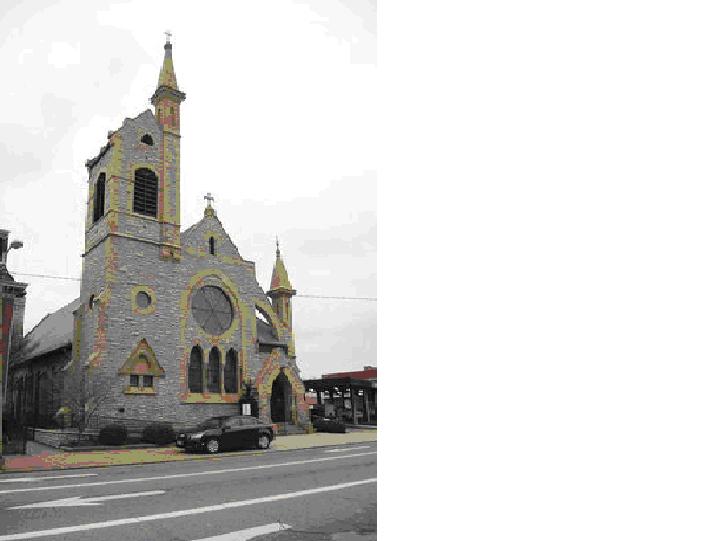Trinity Episcopal has rich history
Will celebrate 170 years
January 6, 2013
By EMILY BALSER (ebalser@newsandsentinel.com) , Parkersburg News and Sentinel
Save | Post a comment |
PARKERSBURG – Trinity Episcopal Church, 430 Juliana St., will celebrate 170 years this year, and behind those 170 years are stories of outreach and community.
The church’s roots go back to 1843 when its first rector, the Rev. Thomas Smith, came to the area and began to form and lead the church. The need for a rector and place of worship came after several English families had moved to the Parkersburg area from Virginia, said the Rev. Larry Jackson, rector of the church.
“After they started their settlement, then they started reaching out for a place to worship,” Jackson said.
Article Photos
Photo by Emily Balser
Trinity Episcopal Church, 430 Juliana St., will celebrate 170 years this year.
Jackson explained those English families had been members of the Church of England, which became known as the Episcopal Church after the Revolutionary War.
“The Church of England is what came to the shores of America first. And it was during the Revolutionary War, when we broke away from England, that the Church of England became known as the Episcopal Church, which means it’s pastored by bishops,” Jackson said.
It wasn’t until three years after Smith arrived in the area that the church had a physical location. The cornerstone for the first church, known then as Trinity Parish, was laid July 11, 1846.
Smith never got to see the completion of the church. He died April 4, 1847. The church wasn’t finished and opened until 1850 under the direction of the new rector, the Rev. E.T. Perkins.
An unusual part of the history of Trinity is that according to church history, Smith is buried under the church steps.
“At his request, he wanted to be buried under the outside steps,” said Barbara Allman, church archivist.
After 30 years, in 1878, the church was torn down and it was decided that a new church would be built. That is the church that remains today. The church was completed on May 4, 1879.
The church was built in a Gothic style and was built of rock and sandstone from local quarries. A few years later, a fund was set up by leaders of the church to raise funds to build an additional building to be used for Sunday school. This would later come to fruition in 1881 and be known as Trinity Hall, which is still used today. Most notably for the community, Trinity Hall is used for the church’s annual book sale.
The book sale is just one of many community and outreach programs the church has held and participated in over the years. The church really began to reach out into the community in the late 1880s under the Rev. S. Scollay Moore.
“In south Parkersburg, in Tavennerville, they started a Sunday school program, which they had hoped would develop into a church but never did,” Jackson said. “Down on The Point where the Ohio and the Little Kanawha come together, they opened a little mission called the lighthouse and its ministry was basically to the people working on the boats. That was the early years of the church.”
Also under Moore, with the guidance of the Rev. George Peterkin, the first bishop of the Episcopal Diocese of West Virginia, the Chapel of the Good Shepherd was opened in 1891. This church is still open today and is located on Charles Street in Parkersburg.
It is known today as The Memorial Church of the Good Shepherd.
“The church has really been noted for its mission to the community since coming here to Parkersburg,” Jackson said.
In 1913 a flood severely damaged the inside of the church. Allman said that during the flood the pews came loose and floated around the church. She said that when they all settled, they were out of order and remain that way today.
“They were just too heavy to pick up,” she said.
Another flood struck in 1937, but didn’t cause as much damage. The church was a little more prepared after the first flood did so much damage.
A few years later in 1940, the Trinity book sale was started as a fundraising effort for the church.
“The whole mission for the book sale was to provide reading material at a cheaper cost,” Jackson said. “And it has just blossomed.”
Allman said that not only does the book sale benefit the church, but also organizations within the community.
“More than half of the book sale proceeds goes to charitable organizations,” she said.
Throughout the mid-to-late 1900s, the church had several renovations.
It also continued to expand its outreach and community programs.
Most recently, the church has been doing a free feeding program for the needy on Mondays. Allman said the church sees hundreds of people coming to get a meal each week.
“It used to be that the only place downtown that did the feeding was the Salvation Army,” Jackson said.
After many changes, Jackson said the church has come to a point where it has settled some and become more stable.
“This church was a transition church, long before I got here. And when DuPont was very active and had lots of people transferring in and out, a lot of people would end up coming to Trinity,” Jackson said. “And it’s now become more stable in the sense of the people who are here are probably the people who are going to be here forever.”


